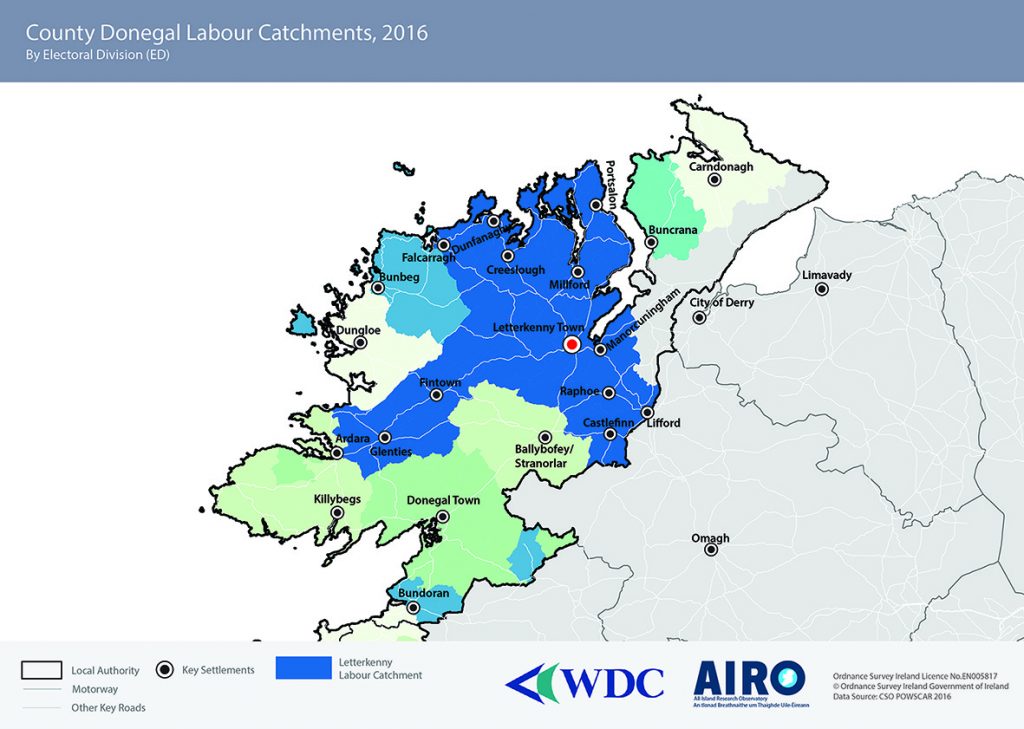Donegal people are travelling further to work and the country’s workforce is ageing, says a Western Development Commission study.
The shifting patterns of Donegal’s labour force are revealed in a detailed new analysis which shows a decline in the number of resident workers in five of the county’s eight labour catchment areas.
A study of census data by analysts at the WDC suggests that Donegal’s larger towns such as Donegal and Letterkenny are continuing to draw workers away from smaller towns such as Ballybofey/Stranolar, Bunbeg, Ballyshannon and Killybegs.
The WDC studied Census data from 2016, comparing some statistics with 2006.
It recorded a rise in the number of people who are ‘cross-border commuting’ to work into Northern Ireland and found that the county has an ageing workforce but with an increasing number of women workers.
The data showed that of eight smaller labour catchments (LCs) in Co Donegal, five recorded a decline (the numbers of resident workers) between 2006 and 2016. A town’s labour catchment is that area from which a town draws most of its workers/labour force/supply.
These are Ballybofey-Stranorlar (-15.7%), Bunbeg (-23%), Ballyshannon (-15.7%), Buncrana (-1.6%) and Killybegs (-11%). Some declines were as a result of increases in neighbouring towns LCs, for example, Donegal (+12%), Dungloe (+39%) & Carndonagh (+32%) and Letterkenny (+10.3%).
Commenting, Western Development Commission policy analyst Deirdre Frost said the figures showed that rural employment was still very important in Co Donegal and is generally the second most important employment location after the town at its centre.
“The results highlight the dispersed nature of employment in many Co Donegal labour catchments. For example, in the case of Donegal town, more employed are outside the town and within the catchment (1,367) than in the town (1227) itself.
“What is also clear is that people are generally travelling further to work, for example the numbers travelling to work to destinations such as Dublin have increased over the ten-year period, this could be in part a legacy from the crash, where people had to travel further to access jobs and have yet to find similar quality employment closer to home. Some of these workers are likely to avail of e-working and facilities at enterprise hubs which can reduce travel time.
“There are over 1,600 workers living in the Derry labour catchment within Donegal and crossing the border to work in Northern Ireland on a daily basis. This provides clear evidence of the extent of cross border commuting and the need to minimise impacts arising out of Brexit and any border arrangements”.
Other key findings reveal:
Donegal’s has an ageing workforce with much fewer workers under 30 years, partly attributable to higher levels of third level participation
Wholesale, retail, Commerce (incl tourism) and Education, Human Health and Social work are generally the two largest sectors often exceeding State employment averages.
More women are working: Carndonagh has high percentage of females in the workforce at 55.3% with Dungloe recording a rate of 56%.
Manufacturing is a particularly strong source of employment in Killybegs at 27%, compared to just 13% across the State while Dungloe recorded an increase in manufacturing employment from 2% in 2006 to 15.5% in 2016.
Rising numbers of Donegal workers are cross-border commuting with the Derry catchment (within Co. Donegal) amounting to 5,056 resident workers in 2016, up from 4,581 in 2006). In 2016, 1,653 of these travelled to work in NI, up from 1,585 in 2006.
Workers are also making the long journey to Dublin. Numbers recorded commuting to Dublin from Ballyshannon were 18; from Killybegs 23; from Ballybofey 23; from Bunbeg 27 and from Donegal 45.
Tags:








